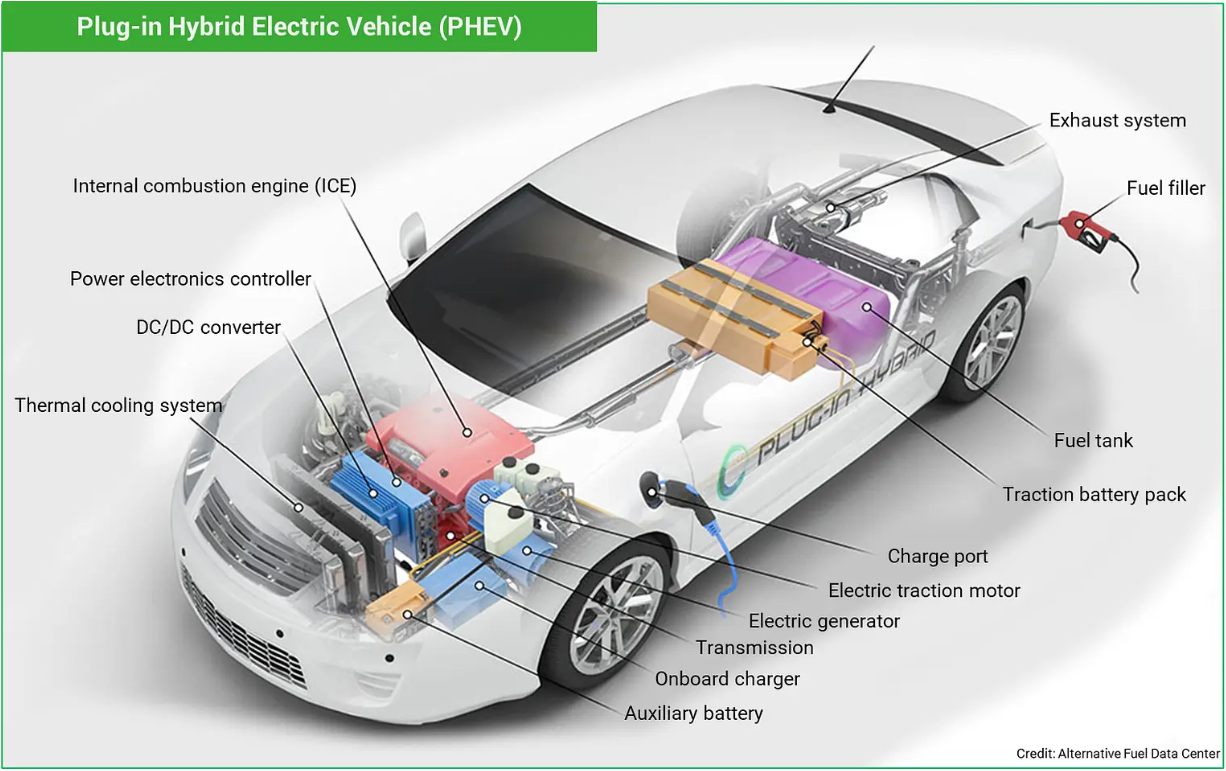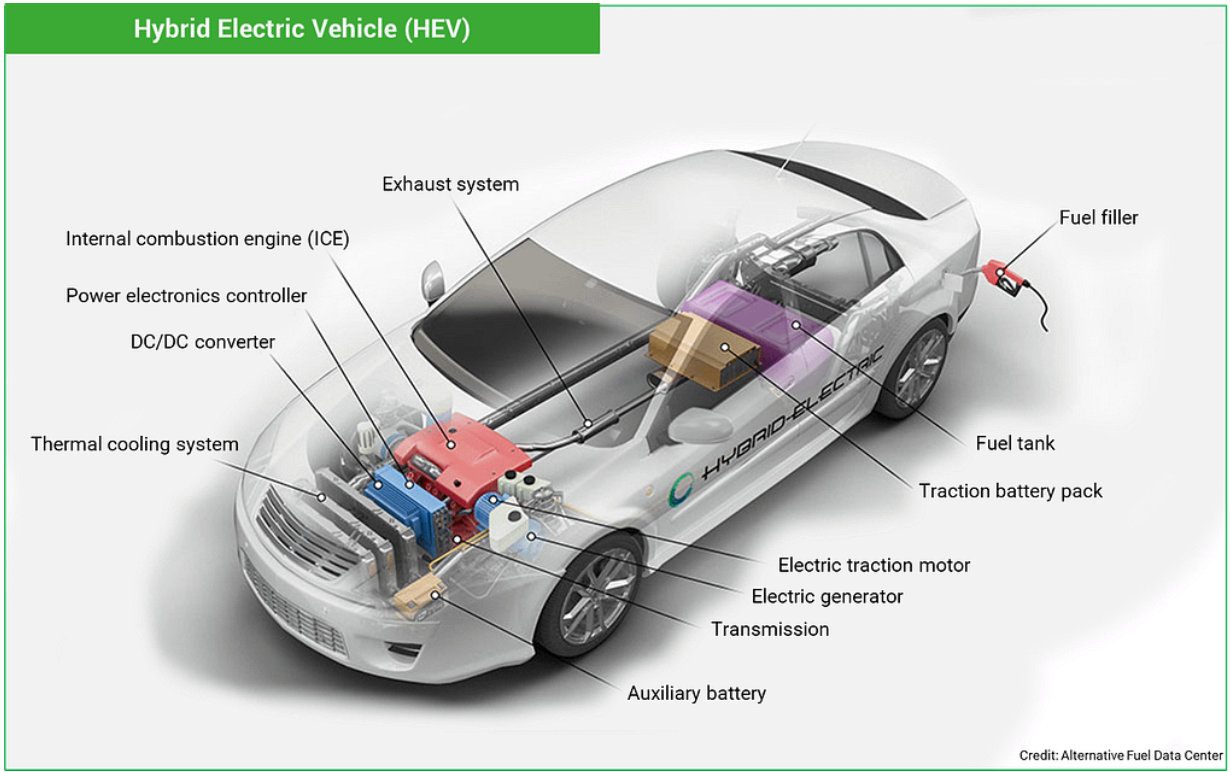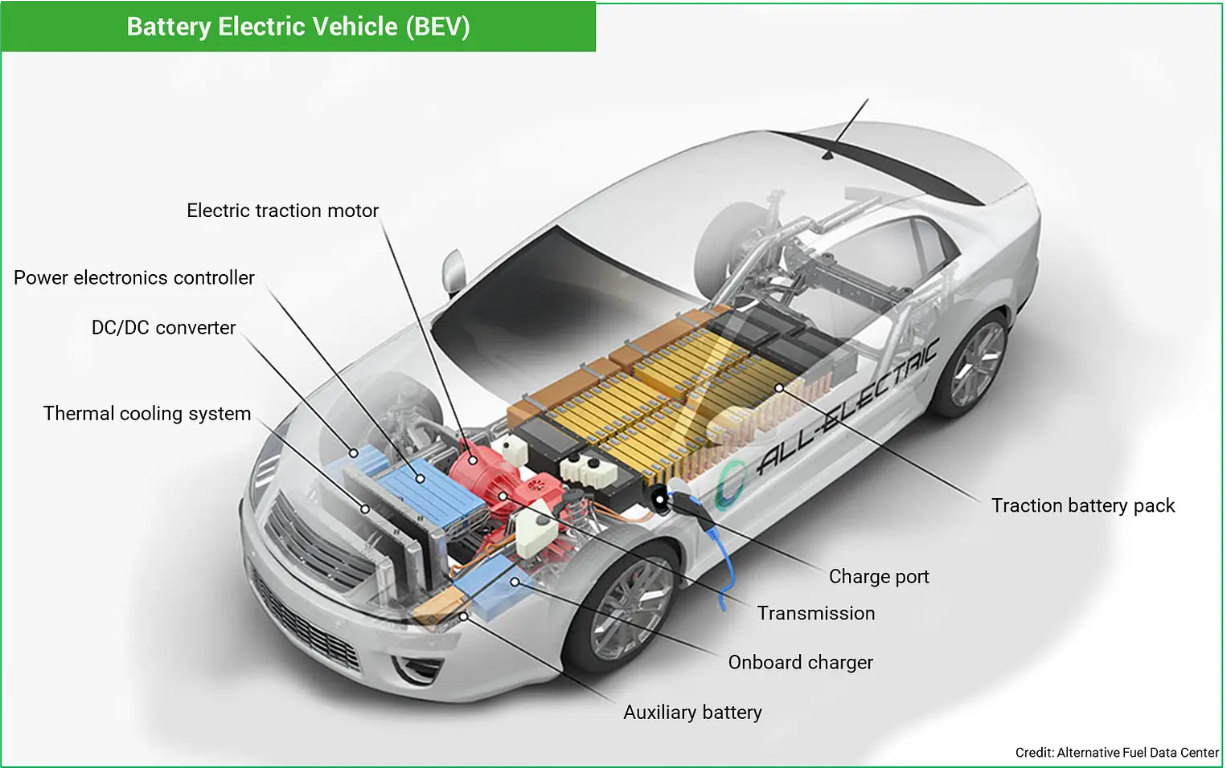Electric vehicles (EVs) have moved from being a niche innovation to a mainstream solution in the automotive industry. As concerns about climate change, energy security, and air pollution grow, the shift to EVs is accelerating worldwide. This article provides an in-depth look at the technical specifications, advancements, and statistics surrounding electric vehicles, highlighting how they are reshaping the future of transportation.
What Are Electric Vehicles?
An electric vehicle (EV) is a vehicle that uses one or more electric motors for propulsion, powered by electricity stored in batteries. Unlike traditional internal combustion engine (ICE) vehicles, EVs do not burn fossil fuels but instead rely on clean energy sources, making them more environmentally friendly.
Types of Electric Vehicles (EVs): A Technical Breakdown
Electric vehicles (EVs) have become a central focus in the automotive industry due to their environmental benefits and technological advancements. In this section, we will explore the different types of electric vehicles, with a deeper dive into their technical aspects, features, and the unique characteristics that differentiate them in terms of performance and energy management.
1. Battery Electric Vehicles (BEVs)
Battery Electric Vehicles (BEVs) are fully electric vehicles that rely solely on electricity stored in their batteries to power an electric motor. They do not have an internal combustion engine (ICE), meaning there are no gasoline or diesel-powered components.
- Key Features:
- Motor and Powertrain: BEVs use one or more electric motors for propulsion, which are powered by lithium-ion or, in some cases, solid-state batteries. These motors operate with high efficiency, often exceeding 90%, compared to internal combustion engines that are only about 25-30% efficient.
- Battery Capacity: BEVs typically feature larger battery packs (ranging from 40 kWh to 100 kWh in many models), enabling them to achieve higher ranges per charge. Battery capacity plays a crucial role in determining the vehicle’s overall range.
- Charging: BEVs can be charged via Level 1 (standard home outlets), Level 2 (240V outlets), and DC fast charging (which can deliver up to 80% of a battery’s capacity in 30 minutes or less).
- Regenerative Braking: Many BEVs feature regenerative braking systems that recapture kinetic energy and convert it into stored energy in the battery when the vehicle decelerates.
- Performance:
- BEVs are known for offering instantaneous torque, which results in smooth and rapid acceleration. For instance, the Tesla Model S Long Range can accelerate from 0 to 60 mph in just 3.1 seconds.
- The range of BEVs can vary from 150 to 400 miles on a full charge, with higher-end models like the Tesla Model S Long Range capable of over 500 miles.
2. Plug-in Hybrid Electric Vehicles (PHEVs)
Plug-in Hybrid Electric Vehicles (PHEVs) combine an internal combustion engine with an electric motor, allowing them to operate in electric-only mode for shorter distances and in hybrid mode for longer trips. This hybrid configuration enables vehicles to offer greater flexibility in fuel usage while reducing emissions.

- Key Features:
- Electric-only Mode: PHEVs are capable of running on electric power alone for a limited distance, typically ranging between 20 to 50 miles. This range allows for short daily trips without the need for gasoline.
- Battery and ICE: PHEVs typically include a smaller battery pack (ranging from 10 kWh to 18 kWh), which is designed to power the electric motor for short distances. The internal combustion engine kicks in for longer trips.
- Dual Power Sources: PHEVs use a combination of the electric motor and an internal combustion engine, which can be powered by gasoline or diesel, depending on the vehicle’s design.
- Charging: The batteries in PHEVs can be charged via Level 1 or Level 2 chargers, much like BEVs. Charging times are generally shorter due to the smaller battery size.
- Performance:
- PHEVs allow drivers to choose between pure electric power for local commutes and gasoline power for long-distance travel, reducing fuel consumption and carbon emissions.
- The transition between electric and gasoline power is typically seamless, offering smooth driving experiences in both modes.
3. Hybrid Electric Vehicles (HEVs)
Hybrid Electric Vehicles (HEVs) are a step between traditional internal combustion engine (ICE) vehicles and fully electric vehicles. These vehicles use both an electric motor and an internal combustion engine but cannot be plugged in to recharge the battery. Instead, the battery is charged through regenerative braking and the operation of the engine itself.

- Key Features:
- Battery and ICE Integration: HEVs use a smaller battery compared to PHEVs or BEVs. The battery typically has a capacity of 1 to 2 kWh, enough to power the electric motor for short distances at low speeds.
- Regenerative Braking: This technology captures energy during braking and feeds it back into the battery, enhancing energy efficiency and reducing the need for frequent fuel stops.
- Fuel Efficiency: Since HEVs don’t need to be plugged in for charging, they are more convenient in regions with limited charging infrastructure. The combination of the electric motor and gasoline engine improves fuel efficiency by allowing the car to use the electric motor at lower speeds and the internal combustion engine when more power is required.
- Performance:
- HEVs offer improved fuel economy compared to conventional ICE vehicles due to their ability to switch seamlessly between electric and gasoline power.
- These vehicles offer a quieter and smoother driving experience compared to traditional vehicles, especially in city driving where the electric motor is used more frequently.
Battery Technology: The Heart of Electric Vehicles
The core of an electric vehicle’s performance lies in its battery. EV batteries, typically lithium-ion (Li-ion) batteries, store electrical energy for propulsion and other vehicle functions. Here are key technical details about these batteries:
- Battery Chemistry:
- Lithium-ion Batteries (Li-ion): Most modern EVs use lithium-ion batteries due to their higher energy density, light weight, and ability to be charged and discharged many times without significant degradation.
- Solid-state Batteries: Solid-state batteries are the next frontier. They promise greater energy density, faster charging times, and enhanced safety by eliminating the flammability risks associated with traditional lithium-ion batteries.
- Energy Density:
- Energy density refers to how much energy a battery can store per unit weight. The average energy density of lithium-ion batteries used in EVs is approximately 150 Wh/kg to 250 Wh/kg.
- For comparison, a typical gasoline-powered car has an energy density of about 12,000 Wh/kg, highlighting why EVs require larger, heavier battery packs to achieve comparable ranges.
- Battery Range:
- Modern EVs offer a range of anywhere from 150 to 400 miles on a single charge, with more premium models reaching beyond 500 miles. For example, the Tesla Model S Long Range can travel up to 370 miles on a full charge.
- Charging Time:
- Charging times have dramatically improved in recent years. With Level 1 chargers, which are typical home outlets, a full charge may take up to 24 hours. However, with Level 2 chargers (240V), this time is reduced to around 4 to 10 hours.
- DC Fast Charging (Supercharging) can charge an EV up to 80% in as little as 30 minutes, and manufacturers like Tesla, Volkswagen, and others have deployed extensive charging infrastructure to support rapid charging.
EV Motors: Efficiency and Power Delivery
Electric motors are another key technological component in EVs. Unlike conventional ICE vehicles, which require transmissions to regulate power, EVs use electric motors that provide power directly to the wheels.
- Motor Efficiency: EV motors are typically more than 90% efficient, compared to 25% to 30% efficiency in internal combustion engines.
- Torque and Acceleration: EVs offer instant torque, meaning they can accelerate more quickly than ICE vehicles. For example, the Tesla Model S Plaid can accelerate from 0 to 60 mph in under 2 seconds, a significant achievement for any production car.
Global Market Trends and EV Adoption Statistics
The global shift toward electric vehicles is backed by strong policy support, technological advancements, and growing consumer demand. Here are some key statistics:
- Sales Growth:
- The global EV market has seen exponential growth. In 2020, over 3 million EVs were sold worldwide, a 43% increase from 2019. This represents about 4% of the global car market.
- By 2030, the global EV market is expected to grow to 30% of total vehicle sales, according to the International Energy Agency (IEA).
- EV Adoption in Major Markets:
- Europe: In 2021, European countries led the world in EV adoption, with countries like Norway, where nearly 50% of all new car sales were EVs. The EU has set ambitious targets for EV adoption, aiming for 30 million EVs on the road by 2030.
- China: As the world’s largest EV market, China accounted for over 50% of global EV sales in 2020. China aims to have 25% of all vehicles sold be electric by 2025.
- United States: The U.S. has been slower to adopt EVs, but sales are rising rapidly, with companies like Tesla, Rivian, and Lucid Motors leading the charge. As of 2021, the U.S. EV market share stands at 2%, but it is expected to increase significantly.
- Electric Vehicle Charging Infrastructure:
- As of 2021, there are over 1.3 million EV charging points globally. The U.S. alone has over 100,000 charging stations, with an average of 3.2 charging points per station.
- The rapid expansion of charging networks, along with technological improvements in charging speed, is expected to further accelerate EV adoption.
Government Policies and Incentives Driving EV Growth
Governments around the world are actively supporting the transition to electric vehicles with various incentives:
- Subsidies and Tax Credits:
- Many countries provide financial incentives to encourage EV purchases. For example, in the U.S., the federal tax credit for EV buyers can be as much as $7,500.
- Similarly, countries like Germany and Norway offer subsidies and rebates to reduce the cost of purchasing EVs.
- Emission Regulations:
- Stricter emissions regulations, particularly in Europe and China, have made it necessary for automakers to shift towards electric powertrains to comply with increasingly stringent emissions standards. The EU Green Deal targets a 55% reduction in CO2 emissions by 2030, further incentivizing the adoption of EVs.
- Charging Infrastructure:
- Governments are also investing in charging infrastructure. For example, the EU has committed to installing one million EV charging points across the continent by 2025.
Recent Advancements in Electric Vehicle Technology
- Solid-State Batteries:
- Solid-state batteries are expected to revolutionize EVs by providing higher energy density, faster charging, and enhanced safety. Companies like Toyota and QuantumScape are making significant progress in this field, with potential commercialization in the next 5-10 years.
- Autonomous EVs:
- Many automakers are integrating autonomous driving technology into their electric vehicles. Tesla, Waymo, and Cruise are leading the way, with the potential for fully autonomous EVs in the coming decade.
- Wireless Charging:
- A new development in EV technology is wireless (inductive) charging. This technology allows EVs to charge without physical plugs, improving convenience and reducing wear and tear on charging ports. BMW and Audi are currently testing wireless charging systems.
- Vehicle-to-Grid (V2G) Technology:
- V2G technology allows electric vehicles to not only draw power from the grid but also supply power back to the grid during peak demand periods. This helps balance supply and demand in the grid while allowing EVs to act as mobile energy storage devices.
Conclusion: The Road Ahead for Electric Vehicles
Electric vehicles are not just a trend but a fundamental shift in the automotive and energy sectors. With continuous advancements in battery technology, autonomous systems, and charging infrastructure, EVs are poised to become the dominant form of transportation in the coming decades. As EV adoption rises and technologies evolve, the impact on global emissions, energy use, and the automotive industry will be profound. The future is electric, and the road ahead is increasingly paved with clean, efficient, and innovative solutions.











